Dear Aspirants, Our IBPS Guide team is providing new series of Reasoning Questions for IBPS Clerk Prelims 2019 so the aspirants can practice it on a daily basis. These questions are framed by our skilled experts after understanding your needs thoroughly. Aspirants can practice these new series questions daily to familiarize with the exact exam pattern and make your preparation effective.
[WpProQuiz 7447]
Ensure Your Ability Before of Exam – Take IBPS Clerk Prelims Free Mock test
Seating arrangement
Direction (1-5): Study the following information carefully and answer the questions given below.
Ten persons P, Q, R, S, T, A, B, C, D and E are sitting in two parallel rows facing each other with equidistance. P, Q, R, S and T are sitting Row-1 and all of them are facing south. A, B, C, D and E are sitting in Row-2 and all of them are facing north.
Only one person sits between C and D. Either E or P sits at one of the extreme ends of the rows. R faces the immediate neighbour of E. Two persons are sitting between Q and R. C is not an immediate neighbour of E. C does not face Q. The number of persons sitting between D and E is two more than the number of persons sitting between R and T. A does not face the person who sits second to the right of T. P sits second to the left of the one who faces E.
1) Who among the following faces R?
a) A
b) C
c) D
d) B
e) Cannot be determined
2) Four of the following five are alike in a certain way and hence form a group. Which one of them is does not belong to that group?
a) C
b) E
c) Q
d) D
e) S
3) How many persons are sitting between B and the one who faces Q?
a) None
b) One
c) Three
d) Two
e) Cannot be determined
4) If B is related to P in a certain way and T is related to C in the same way. Then, R is related to which of the following?
a) D
b) Either C or R
c) A
d) B
e) E
5) Who among the following sits third to the right of Q?
a) S
b) R
c) T
d) P
e) Either S or R
Puzzles
Direction (6-10): Study the following information carefully and answer the questions given below.
There are eight persons born in different years viz., 1972, 1978, 1983, 1985, 1992, 1994, 1997 and 2000 but not necessary in the same order. Their ages were calculated based on the year 2018 and also they were born in the same date of the same month in the given different years.
Only two persons are born between T and P, whose age is multiple of 11. N was born in one of the even numbered years but not the youngest person. S was born immediately before N. As many persons born after Q is same as the people born before M. Neither Q nor M is the youngest person. More than two persons were born between R and V, who is elder than Q.
6) M was born in which of the following years?
a) 1978
b) 1983
c) 1994
d) 1997
e) 1972
7) How many persons are born between V and Q?
a) None
b) One
c) Two
d) Three
e) More than three
8) Four of the following five are alike in a certain way and they form a group. Which of the following one that does not belong to the group?
a) M
b) V
c) S
d) R
e) N
9) If N is related to P and Q is related to S in a certain way. Then, V is related to which of the following?
a) M
b) N
c) Q
d) R
e) T
10) What is the age difference between V and N?
a) 14 years
b) 5 years
c) 11 years
d) 12 years
e) 7 years
Answers :
Direction (1-5):
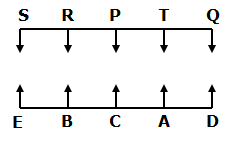
P sits second to the left of the one who faces E. Either E or P sits at one of the extreme ends of the rows. R faces the immediate neighbour of E. Two persons are sitting between Q and R.

C is not an immediate neighbour of E. Only one person sits between C and D. C does not face Q. The number of persons sitting between D and E is two more than the number of persons sitting between R and T.
So, Case-2 will be dropped.

A does not face the person who sits second to the right of T.

1) Answer: D
2) Answer: A
3) Answer: D
4) Answer: E
5) Answer: B
Direction (6-10):
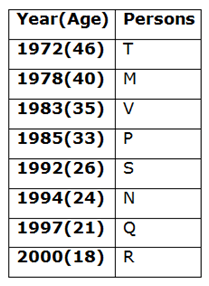
Only two persons are born between T and P, whose age is multiple of 11. N was born in one of the even numbered years but not the youngest person. S was born immediately before N.
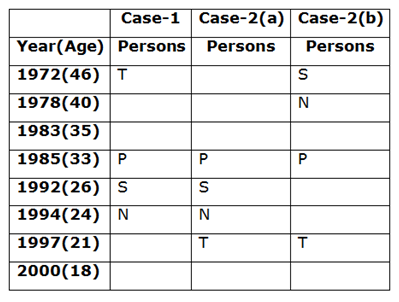
As many persons born after Q is same as the people born before M. Neither Q nor M is the youngest person.
So, Case-2(a) will be dropped.
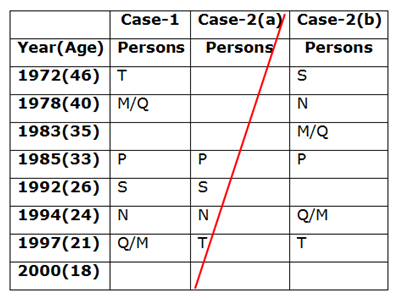
More than two persons were born between R and V, who is elder than Q.
So, Case-2(b) will be dropped.
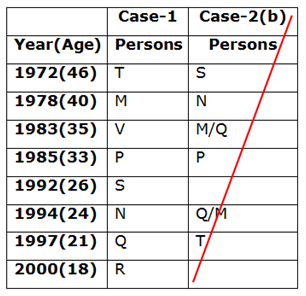
6) Answer: A
7) Answer: D
8) Answer: B
9) Answer: E
10) Answer: C





